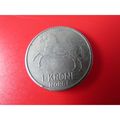Animals - Venomous Jellyfish - postcard by BM (Natural History) c.1960s
- Condition : Used
- Dispatch : 2 Days
- Brand : None
- ID# : 205016267
- Quantity : 1 item
- Views : 189
- Location : United Kingdom

- Seller : justthebook (+1704)
- Barcode : None
- Start : Fri 01 Oct 2021 09:20:46 (EDT)
- Close : Run Until Sold
- Remain : Run Until Sold
Checks/Cheques
 for 1 item(s) edit
for 1 item(s) edit
Shipping Calculator
More Listings from This Seller view all
Seller's Description
- Postcard
- Picture / Image: Venomous Jellyfish - Chrysaora hysoscella / Cyanea capillata / Pelagia noctilca (Forskal)
- Publisher: British Museum (Natural History) [now Natural History Museum]
- Postally used: no
- Stamp: n/a
- Postmark(s): n/a
- Sent to: n/a
- Notes / condition:
Please ask if you need any other information and I will do the best I can to answer.
Image may be low res for illustrative purposes - if you need a higher definition image then please contact me and I may be able to send one. No cards have been trimmed (unless stated).
------------------------------------------------
Postage & Packing:
Postage and packing charge should be showing for your location (contact if not sure).
No additional charges for more than one postcard. You can buy as many postcards from me as you like and you will just pay the fee above once. Please wait for combined invoice. (If buying postcards with other things such as books, please contact or wait for invoice before paying).
Payment Methods:
UK - PayPal, Cheque (from UK bank) or postal order
Outside UK: PayPal ONLY (unless otherwise stated) please. NO non-UK currency checks or money orders (sorry).
NOTE: All postcards are sent in brand new stiffened envelopes which I have bought for the task. These are specially made to protect postcards and you may be able to re-use them. In addition there are other costs to sending so the above charge is not just for the stamp!
I will give a full refund if you are not fully satisfied with the postcard.
----------------------------------------------
Text from the free encyclopedia WIKIPEDIA may appear below to give a little background information (internal links may not work) :
*************
Jellyfish and sea jellies are the informal common names given to the medusa-phase of certain gelatinous members of the subphylum Medusozoa, a major part of the phylum Cnidaria. Jellyfish are mainly free-swimming marine animals with umbrella-shaped bells and trailing tentacles, although a few are anchored to the seabed by stalks rather than being mobile. The bell can pulsate to provide propulsion for highly efficient locomotion. The tentacles are armed with stinging cells and may be used to capture prey and defend against predators. Jellyfish have a complex life cycle; the medusa is normally the sexual phase, which produces planula larva that disperse widely and enter a sedentary polyp phase before reaching sexual maturity.
Jellyfish are found all over the world, from surface waters to the deep sea. Scyphozoans (the "true jellyfish") are exclusively marine, but some hydrozoans with a similar appearance live in freshwater. Large, often colorful, jellyfish are common in coastal zones worldwide. The medusae of most species are fast-growing, and mature within a few months then die soon after breeding, but the polyp stage, attached to the seabed, may be much more long-lived. Jellyfish have been in existence for at least 500 million years,[1] and possibly 700 million years or more, making them the oldest multi-organ animal group.[2]
Jellyfish are eaten by humans in certain cultures. They are considered a delicacy in some Asian countries, where species in the Rhizostomae order are pressed and salted to remove excess water. Australian researchers have described them as a "perfect food", sustainable, and protein-rich but relatively low-calorie.[3]
They are also used in research, where the green fluorescent protein used by some species to cause bioluminescence has been adapted as a fluorescent marker for genes inserted into other cells or organisms.
The stinging cells used by jellyfish to subdue their prey can injure humans. Many thousands of swimmers are stung every year, with effects ranging from mild discomfort to serious injury or even death; small box jellyfish are responsible for many of these deaths. When conditions are favourable, jellyfish can form vast swarms, which can be responsible for damage to fishing gear by filling fishing nets, and sometimes clog the cooling systems of power and desalination plants which draw their water from the sea.
Listing Information
| Listing Type | Gallery Listing |
| Listing ID# | 205016267 |
| Start Time | Fri 01 Oct 2021 09:20:46 (EDT) |
| Close Time | Run Until Sold |
| Starting Bid | Fixed Price (no bidding) |
| Item Condition | Used |
| Bids | 0 |
| Views | 189 |
| Dispatch Time | 2 Days |
| Quantity | 1 |
| Location | United Kingdom |
| Auto Extend | No |














![ÄTHIOPIEN ETHIOPIA [1962] MiNr 0420 ( O/used )](https://pic.ebid.net/upload_small/3/7/6/1471787975-882-6.jpg)






